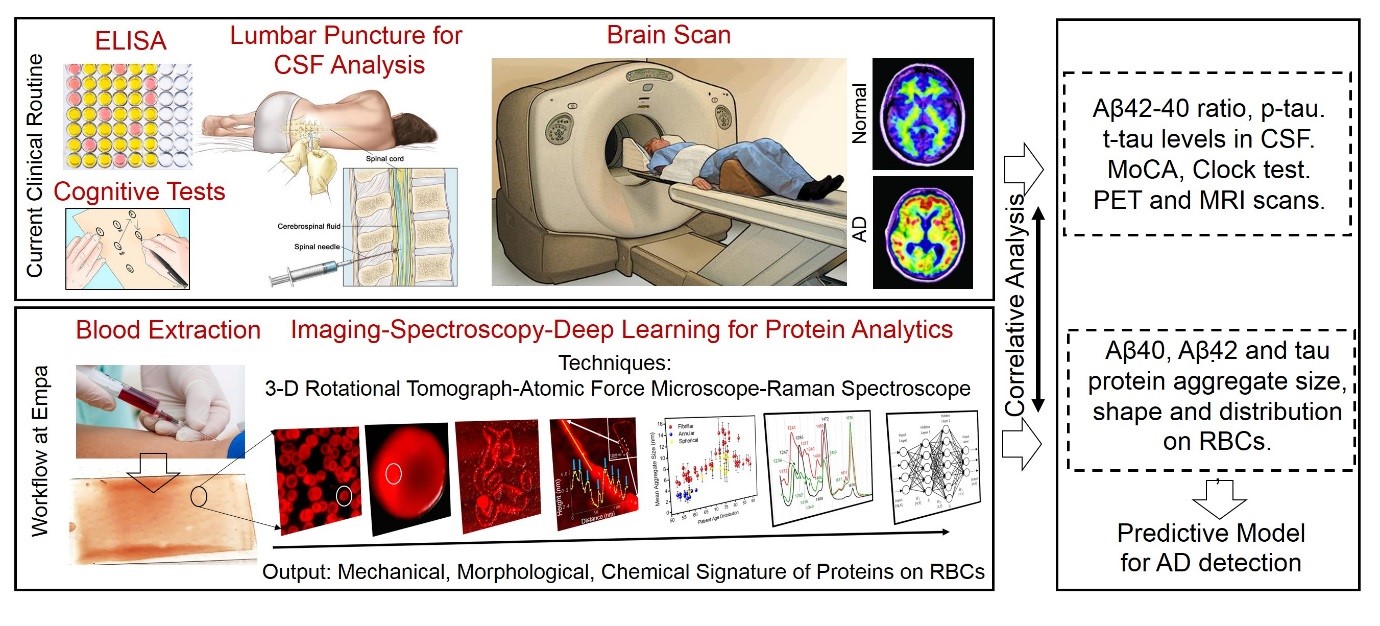Decoding Alzheimer’s Protein Aggregation in Body Fluids

Figure 1: Introduction to the workflow and expected outcome of research activities in the lab of the PI at Empa aimed towards presymptomatic detection of Alzheimer’s disease.
Short abstract: The two main proteins implicated in the pathology of AD are amyloid-beta and tau isoforms whose total content can be quantified in cerebrospinal fluid (CSF), blood plasma and serum. Yet, differences in morphology of these shape-shifting proteins in body fluids, which are also key indicators of disease stage, remains largely unknown and hence unavailable to clinicians. Recently, we discovered that the physical biomarkers (size, shape, morphology, assembly patterns and prevalence) of these protein aggregates on red blood cells (RBCs) strongly correlate with neurocognitive disorder levels in patients (Nirmalraj et al, Science Advances, 7, eabj2137, 2021). Our goal and vision are to investigate these new class of biomarkers and integrate them with clinical decision making to diagnose AD before it destroys cognition and memory in individuals.
In this context, the proposed master thesis project will focus on resolving and quantifying the aggregation pathway of synthetically prepared Tau proteins at solid liquid interface using nanoscale imaging and chemical spectroscopy. The complete aggregation pathway from onset of oligomers to fibrils will be captured at single particle level using atomic force microscopy, electron microscopy and also the chemical structure resolved using Infrared and Raman spectroscopy. Knowledge developed in this project will serve as guidelines for classification of protein aggregates in blood and CSF from patients at various stages of decline in memory and cognition.
Description: The experimental work will include preparation of protein aggregates in buffer salt solutions, protein concentration measurements, atomic force microscopy (tapping mode, Dimension Icon AFM), Raman spectroscopy (WiTEC System) and AFM/IR Spectroscopy (Nanosys AFM-IR). Over the course of the project the student will also be introduced to preclinical research projects for early detection of Alzheimer’s disease, which is the ongoing main project in the lab of the PI at Empa. (https://www.admin.ch/gov/en/start/documentation/media-releases.msg-id-85267.html).
Goal: To resolve, quantify and classify pathological proteins assembly at solid liquid interface implicated in Alzheimer’s disease.
Contact details: Dr. Peter Nirmalraj, Biosensing and Functional Surfaces, Transport at Nanoscale Interfaces Laboratory. (/web/s405/biosensing).

